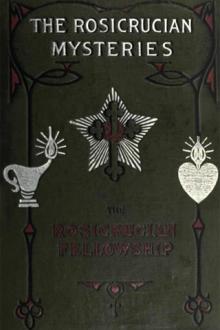The Unknown Life of Jesus Christ by Nicolas Notovitch (good short books .TXT) 📕

- Author: Nicolas Notovitch
- Performer: -
Book online «The Unknown Life of Jesus Christ by Nicolas Notovitch (good short books .TXT) 📕». Author Nicolas Notovitch
Polyandry, by the way, has even flourished in Europe, if we may believe Cæsar, who, in his De Bello Gallico, book V., page 17, writes: "Uxores habent deni duodenique inter se communes, et maxime fratres cum fratribus et parentes cum liberis."
In view of all this it is impossible to hold any religion responsible for the existence of the institution of polyandry. In Thibet it can be explained by motives of an economical nature; the small quantity of arable land falling to the share of each inhabitant. In order to support the 1,500,000 inhabitants distributed in Thibet, upon a surface of 1,200,000 square kilometres, the Buddhists were forced to adopt polyandry. Moreover, each family is bound to enter one of its members in a religious order. The firstborn is consecrated to a gonpa, which is inevitably found upon an elevation, at the entrance of every village. As soon as the child attains the age of eighteen years, he is entrusted to the caravans which pass Lhassa, where he remains from eight to fifteen years as a novice, in one of the gonpas which are near the city. There he learns to read and write, is taught the religious rites and studies the sacred parchments written in the Pali language—which formerly used to be the language of the country of Maguada, where, according to tradition, Buddha was born.
The oldest brother remaining in a family chooses a wife, who becomes common to his brothers. The choice of the bride and the nuptial ceremonies are most rudimentary. When a wife and her husband have decided upon the marriage of a son, the brother who possesses the right of choice, pays a visit to a neighboring family in which there is a marriageable daughter.
The first and second visits are spent in more or less indifferent conversations, blended with frequent libations of tchang, and on the third visit only does the young man declare his intention to take a wife. Upon this the girl is formally introduced to him. She is generally not unknown to the wooer, as, in Ladak, women never veil their faces.
A girl cannot be married without her consent. When the young man is accepted, he takes his bride to his house, and she becomes his wife and also the wife of all his brothers. A family which has an only son sends him to a woman who has no more than two or three husbands, and he offers himself to her as a fourth husband. Such an offer is seldom declined, and the young man settles in the new family.
The newly married remain with the parents of the husbands, until the young wife bears her first child. The day after that event, the grandparents of the infant make over the bulk of their fortune to the new family, and, abandoning the old home to them, seek other shelter.
Sometimes marriages are contracted between youth who have not reached a marriageable age, but in such event, the married couple are made to live apart, until they have attained and even passed the age required. An unmarried girl who becomes enceinte, far from being exposed to the scorn of every one, is shown the highest respect; for she is demonstrated fruitful, and men eagerly seek her in marriage. A wife has the unquestioned right of having an unlimited number of husbands and lovers. If she likes a young man, she takes him home, announces that he has been chosen by her as a "jingtuh" (a lover), and endows him with all the personal rights of a husband, which situation is accepted by her temporarily supplanted husbands with a certain philosophic pleasure, which is the more pronounced if their wife has proved sterile during the three first years of her marriage.
They certainly have here not even a vague idea of jealousy. The Thibetan's blood is too cold to know love, which, for him, would be almost an anachronism; if indeed he were not conscious that the sentiment of the entire community would be against him, as a flagrant violator of popular usage and established rights, in restraining the freedom of the women. The selfish enjoyment of love would be, in their eyes, an unjustifiable luxury.
In case of a husband's absence, his place may be offered to a bachelor or a widower. The latter are here in the minority, since the wife generally survives her feeble husbands. Sometimes a Buddhist traveller, whom his affairs bring to the village, is chosen for this office. A husband who travels, or seeks for work in the neighboring country, at every stop takes advantage of his co-religionists' hospitality, who offer him their own wives. The husbands of a sterile woman exert themselves to find opportunities for hospitality, which may happily eventuate in a change in her condition, that they may be made happy fathers.
The wife enjoys the general esteem, is ever of a cheerful disposition, takes part in everything that is going on, goes and comes without any restriction, anywhere and everywhere she pleases, with the exception of the principal prayer-room of the monastery, entrance into which is formally prohibited to her.
Children know only their mother, and do not feel the least affection for their fathers, for the simple reason that they have so many. Without approving polyandry, I could not well blame Thibet for this institution, since without it, the population would prodigiously increase. Famine and misery would fall upon the whole nation, with all the sinister sequellæ of murder and theft, crimes so far absolutely unknown in the whole country.
A Festival in a GonpaLeh, the capital of Ladak, is a little town of 5,000 inhabitants, who live in white, two-story houses, upon two or three streets, principally. In its centre is the square of the bazaar, where the merchants of India, China, Turkestan, Kachmyr and Thibet, come to exchange their products for the Thibetan gold. Here the natives provide themselves with cloths for themselves and their monks, and various objects of real necessity.
An old uninhabited palace rises upon a hill which dominates the town. Fronting the central square is a vast building, two stories in height, the residence of the governor of Ladak, the Vizier Souradjbal—a very amiable and universally popular Pendjaban, who has received in London the degree of Doctor of Philosophy.
To entertain me, during my sojourn in Leh, the governor arranged, on the bazaar square, a game of polo—the national sport of the Thibetans, which the English have adopted and introduced into Europe. In the evening, after the game, the people executed dances and played games before the governor's residence. Large bonfires illuminated the scene, lighting up the throng of inhabitants, who formed a great circle about the performers. The latter, in considerable numbers, disguised as animals, devils and sorcerers, jumped and contorted themselves in rhythmic dances timed to the measure of the monotonous and unpleasing music made by two long trumpets and a drum.
The infernal racket and shouting of the crowd wearied me. The performance ended with some graceful dances by Thibetan women, who spun upon their heels, swaying to and fro, and, in passing before the spectators in the windows of the residence, greeted us by the clashing together of the copper and ivory bracelets on their crossed wrists.
The next day, at an early hour, I repaired to the great Himis convent, which, a little distance from Leh, is elevated upon the top of a great rock, on a picturesque site, commanding the valley of the Indies. It is one of the principal monasteries of the country, and is maintained by the gifts of the people and the subsidies it receives from Lhassa. On the road leading to it, beyond the bridge crossing the Indus, and in the vicinity of the villages lining the way, one finds heaps of stones bearing engraved inscriptions, such as have already been described, and t'horthenes. At these places, our guides were very careful to turn to the right. I wished to turn my horse to the left, but the Ladakians made him go back and led him by his halter to the right, explaining to me that such was their established usage. I found it impossible to learn the origin or reason of this custom.
Above the gonpa rises a battlemented tower, visible from a great distance. We climbed, on foot, to the level on which the edifice stands and found ourselves confronted by a large door, painted in brilliant colors, the portal of a vast two-story building enclosing a court paved with little pebbles. To the right, in one of the angles of the court, is another huge painted door, adorned with big copper rings. It is the entrance to the principal temple, which is decorated with paintings of the principal gods, and contains a great statue of Buddha and a multitude of sacred statuettes. To the left, upon a verandah, was placed an immense prayer-cylinder. All the lamas of the convent, with their chief, stood about it, when we entered the court. Below the verandah were musicians, holding long trumpets and drums.
At the right of the court were a number of doors, leading to the rooms of the lamas; all decorated with sacred paintings and provided with little prayer-barrels fancifully surmounted by black and white tridents, from the points of which floated ribbons bearing inscriptions—doubtless prayers. In the centre of the court were raised two tall masts, from the tops of which dangled tails of yaks, and long paper streamers floated, covered with religious inscriptions. All along the walls were numerous prayer-barrels, adorned with ribbons.
A profound silence reigned among the many spectators present. All awaited anxiously the commencement of a religious "mystery," which was about to be presented. We took up a position near the verandah. Almost immediately, the musicians drew from their long trumpets soft and monotonous tones, marking the time by measured beats upon an odd-looking drum, broad and shallow, upreared upon a stick planted in the ground. At the first sounds of the strange music, in which joined the voices of the lamas in a melancholy chant, the doors along the wall opened simultaneously, giving entrance to about twenty masked persons, disguised as animals, birds, devils and imaginary monsters. On their breasts they bore representations of fantastic dragons, demons and skulls, embroidered with Chinese silk of various colors. From the conical hats they wore, depended to their breasts long multicolored ribbons, covered with inscriptions. Their masks were white death's-heads. Slowly they marched about the masts, stretching out their arms from time to time and flourishing with their left hands spoon-shaped objects, the bowl portions of which were said to be fragments of human crania, with ribbons attached, having affixed to their ends human hair, which, I was assured, had been taken from scalped enemies. Their promenade, in gradually narrowing circles about the masts, soon became merely a confused jostling of each other; when the rolling of the drum grew more accentuated, the performers for an instant stopped, then started again, swinging above their heads yellow sticks, ribbon-decked, which with their right hands they brandished in menacing attitudes.
After making a salute to the chief lama, they approached the door leading to the temple, which at this instant opened, and from it another band came forth, whose heads were covered by copper masks. Their dresses were of





Comments (0)